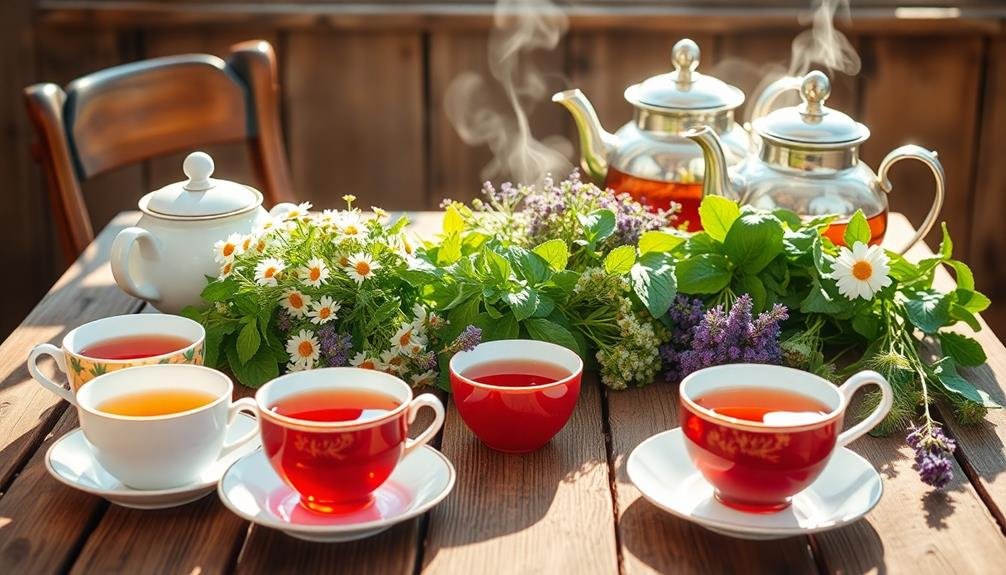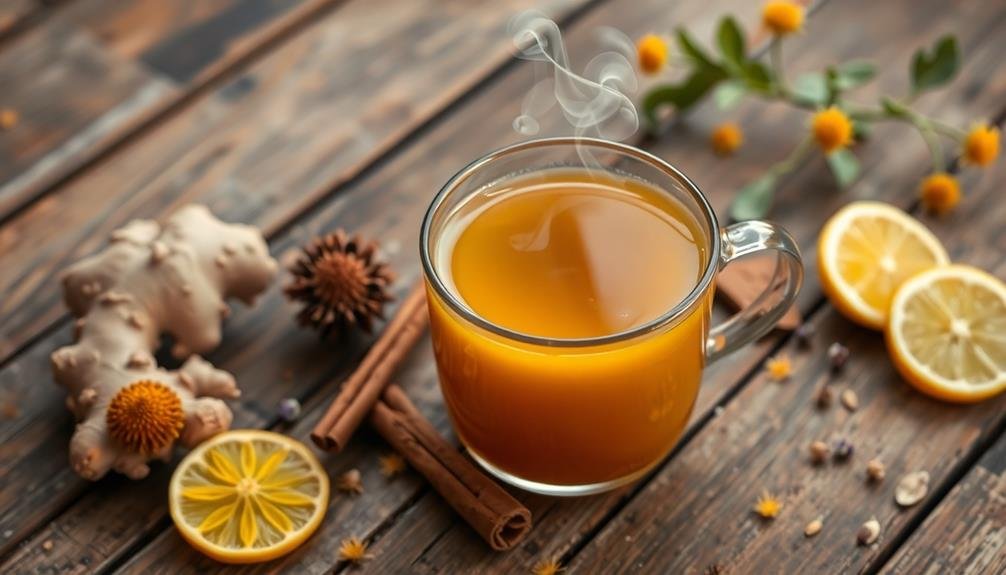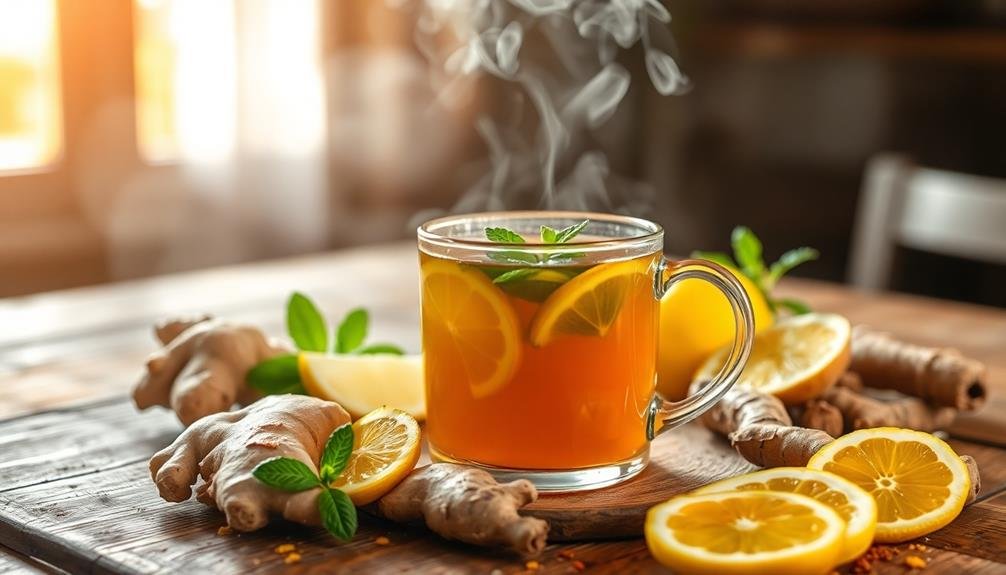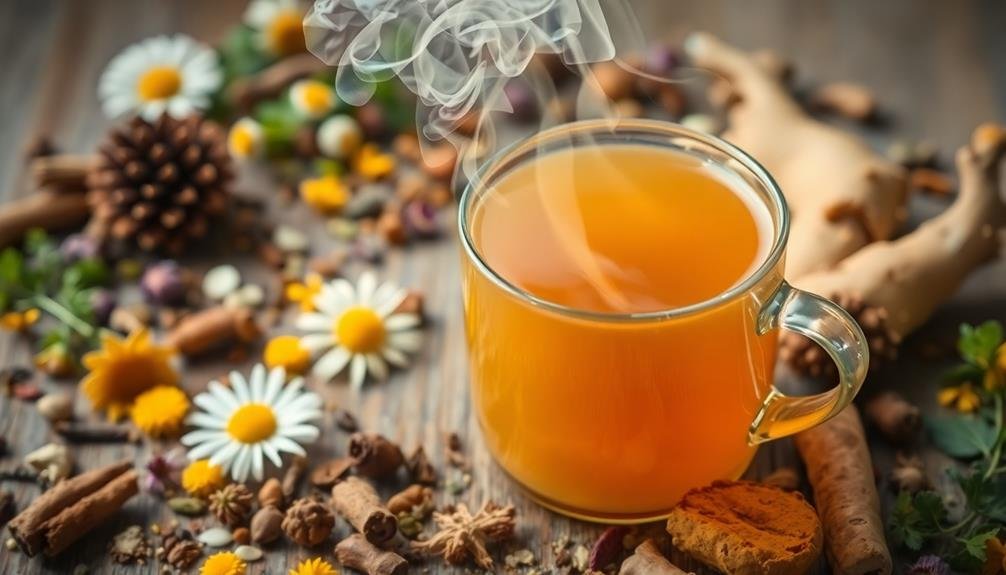Choosing specific herbs for your tea blends enhances both flavor and health benefits. For instance, chamomile soothes your mind, while peppermint aids digestion, making them perfect companions. Ginger provides a warm kick and boosts your immune system, while hibiscus offers a tart taste and rich antioxidants. Combining these herbs not only creates interesting flavors, but also supports your wellness goals. Plus, experimenting with different blends can lead to unique and enjoyable experiences. If you're curious about how to craft your perfect blend, there's plenty more to explore on combinations and brewing techniques.
Benefits of Herbal Teas

Herbal teas offer a delightful way to boost your health while enjoying a comforting beverage. These infusions are packed with a variety of beneficial compounds that can enhance your well-being. By sipping on herbal teas, you can support digestion, reduce stress, and improve your overall mood.
One of the most appealing aspects of herbal teas is their ability to provide hydration without caffeine. This makes them an excellent choice for those looking to cut back on stimulants while still enjoying a flavorful drink. Many herbal blends contain antioxidants, which combat oxidative stress and promote a healthy immune system.
You'll also find that certain herbs can aid in relaxation and better sleep. When you're feeling anxious or restless, a warm cup of chamomile or lavender tea can work wonders. Additionally, some herbal teas, like ginger or peppermint, can soothe upset stomachs and alleviate nausea.
Incorporating herbal teas into your daily routine is an easy and enjoyable way to reap these health benefits. Whether you prefer a warm brew or an iced version, these teas can become a delightful part of your wellness journey.
Popular Herbs for Blending
When blending herbs for tea, you'll want to explore a variety of flavor profiles to find what suits your taste.
Each herb not only adds unique flavors but also comes with its own set of health benefits.
Let's look at some popular herbs that can elevate your tea experience.
Flavor Profiles Explored
Exploring the diverse flavor profiles of herbs opens up a world of possibilities for your tea blends. Each herb brings its unique taste, allowing you to create a delightful, aromatic experience.
For instance, peppermint offers a revitalizing and invigorating flavor, perfect for a morning pick-me-up. If you're after something more soothing, chamomile provides a gentle, floral note that calms the senses.
Consider adding hibiscus for a tart, fruity punch; its vibrant color and tangy profile can brighten any blend. On the other hand, lemongrass introduces a zesty, citrusy kick that can elevate your tea, making it lively and invigorating.
You might also want to explore the earthy undertones of rooibos, which pairs beautifully with sweeter herbs like vanilla or cinnamon. This combination can create a warm, comforting cup, ideal for cozy evenings.
Health Benefits Highlighted
Often overlooked, the health benefits of popular herbs can greatly enhance your tea blends. When you choose herbs like chamomile, you're not just adding flavor; you're also tapping into its calming properties, which can help reduce stress and promote better sleep.
Peppermint, on the other hand, offers a rejuvenating taste and aids digestion, making it perfect for post-meal blends. If you're looking for a boost, consider adding ginger. It's known for its anti-inflammatory properties and can help with nausea, giving your tea a spicy kick.
Similarly, hibiscus not only provides a vibrant color but also supports heart health and is rich in antioxidants. You might also enjoy the benefits of lemon balm, which is great for relaxation and mental clarity.
In addition, adding adaptogenic herbs like ashwagandha can help your body manage stress, enhancing both flavor and wellness.
Flavor Profiles of Herbs

Herbs offer a diverse range of flavor profiles that can transform your tea blends into unique experiences. Each herb brings its own distinct taste that can enhance or complement other ingredients in your blend. By understanding these flavors, you can craft teas that excite the palate.
Here's a quick overview of some popular herbs and their flavor profiles:
| Herb | Flavor Profile |
|---|---|
| Chamomile | Sweet, floral, and calming |
| Peppermint | Cool, invigorating, and minty |
| Lemongrass | Citrusy, bright, and zesty |
| Lavender | Floral, slightly sweet, and soothing |
| Ginger | Spicy, warm, and invigorating |
Experimenting with different combinations lets you discover new favorites. For instance, blending chamomile with peppermint creates a soothing yet invigorating cup, while adding ginger to lemongrass gives a lively kick. Don't hesitate to mix and match until you find the perfect balance! Each sip can be a delightful journey through the aromatic world of herbs. So, get creative with your blends and let your taste buds explore!
Health Benefits of Specific Herbs
While you savor the delightful flavors of herbal teas, it's also important to contemplate the health benefits these specific herbs can offer. Each herb you choose can contribute to your well-being in unique ways.
For instance, chamomile is well-known for its calming properties, helping to ease anxiety and promote better sleep. If you're looking for digestion support, peppermint tea can work wonders by alleviating discomfort and bloating.
Then there's ginger, which is fantastic for boosting your immune system and reducing inflammation. It can also help soothe nausea, making it an excellent choice for those feeling under the weather.
Lavender not only adds a soothing aroma but also helps to reduce stress and tension, making your tea-drinking experience even more relaxing.
Don't overlook hibiscus, either! This vibrant herb is rich in antioxidants and may help lower blood pressure and improve heart health.
Drying Techniques for Herbs

When you're ready to preserve your herbs for tea blends, choosing the right drying method is essential.
You can air dry, use an oven, or opt for a dehydrator, each offering unique benefits.
Let's explore these techniques so you can decide which works best for you.
Air Drying Methods
For creating flavorful tea blends, air drying is one of the simplest and most effective methods to preserve your herbs. This technique allows you to maintain the essential oils and vibrant flavors that make your tea special.
To start, you'll want to choose fresh, healthy herbs. Rinse them gently to remove any dirt, then pat them dry with a clean towel.
Next, gather your herbs into small bundles, securing them with string or rubber bands. Hang them upside down in a well-ventilated, dark area to prevent light from degrading their quality. Make sure the location is warm and dry, as humidity can lead to mold growth.
You can also lay the herbs flat on a screen or mesh tray, ensuring they're spaced apart for ample airflow. Check your herbs every few days; they're ready when they feel crisp and crumble easily. This process usually takes one to three weeks, depending on the herb and environmental conditions.
Once dried, store your herbs in airtight containers, away from light and moisture. With proper air drying, you'll enjoy the rich flavors of your homegrown herbs in every cup of tea!
Oven Drying Techniques
Oven drying is a quick and efficient method for preserving herbs, especially when you're short on time. To get started, preheat your oven to a low temperature—around 180°F (82°C) typically works best.
Next, wash your herbs gently to remove any dirt and pat them dry with a clean towel. Spread the herbs evenly on a baking sheet lined with parchment paper, making sure they're not overlapping.
Place the baking sheet in the oven, leaving the door slightly ajar to allow moisture to escape. This step is vital, as it helps prevent the herbs from becoming too steamed.
Check on your herbs every 15 minutes, giving them a gentle stir to guarantee even drying. Depending on the type and moisture content, the drying process can take anywhere from 30 minutes to an hour.
When your herbs feel crisp and crumble easily, they're done. Let them cool completely before storing them in an airtight container.
This method not only saves time but also retains the vibrant flavors and aromas that make your tea blends special. With a bit of practice, oven drying can become a go-to technique for your herb preservation needs.
Dehydrator Usage Tips
Using a dehydrator is one of the best ways to preserve herbs while maintaining their flavor and nutrients. To get started, verify your herbs are fresh and free from dirt or insects. Rinse them gently and pat them dry with a towel.
Next, remove any tough stems and arrange the leaves in a single layer on the dehydrator trays. Avoid overcrowding; good air circulation is key for even drying.
Set your dehydrator to the appropriate temperature, usually between 95°F to 115°F, depending on the type of herb. Leafy herbs like basil and parsley typically dry faster than sturdier varieties like rosemary or thyme.
Check your herbs periodically; most will take anywhere from 1 to 4 hours to dry. Once the herbs are brittle and crumble easily, they're done.
Let them cool before transferring them to airtight containers to prevent moisture from getting in. Label each container with the herb's name and drying date to keep track.
Store them in a cool, dark place to maintain their flavor for as long as possible. With these tips, you'll enjoy flavorful herbal teas all year round!
Storing Herbs for Freshness
To keep your herbs fresh and flavorful, you'll want to store them properly right after harvesting or purchasing. First, make sure your herbs are completely dry; any moisture can lead to mold and spoilage. If you've just harvested them, gently rinse and pat them dry before storage.
Next, choose the right containers. Glass jars with tight-fitting lids are excellent for dried herbs, as they protect against light and air, which can degrade flavor.
If you prefer to store fresh herbs, place them in a glass of water like a bouquet, covering the stems and leaving the leaves exposed. You can also wrap them in a damp paper towel and place them in a plastic bag in the fridge.
Label your containers with the herb name and date to keep track of freshness. For dried herbs, aim to use them within a year for the best flavor.
Combining Flavors and Benefits

When crafting your tea blends, you'll often want to combine herbs that not only complement each other in flavor but also enhance the health benefits of your brew.
Think about pairing herbs with similar properties. For instance, if you're looking for relaxation, chamomile and lavender work beautifully together, creating a soothing blend that calms the mind and body.
Moreover, consider the balance of flavors. If you add a strong herb like peppermint, balance it with a milder herb like lemongrass. This way, you won't overpower the taste but still enjoy the digestive benefits peppermint offers alongside the invigorating qualities of lemongrass.
You can also mix herbs with different health benefits to create a well-rounded blend. For instance, combining ginger for digestion with hibiscus for heart health can yield a flavorful tea that supports overall wellness.
Don't forget to experiment! Trying different combinations will help you discover unique flavors and benefits.
Taking the time to understand how herbs work together allows you to craft blends that not only taste good but also elevate your health.
Crafting Your Unique Blend
Crafting your unique tea blend starts with understanding your personal preferences and goals. Think about what flavors you enjoy—do you lean towards the sweetness of chamomile, the earthiness of rooibos, or the brightness of lemon balm?
Consider the benefits you seek, too. Are you looking for relaxation, digestion support, or a boost of energy?
Once you've pinpointed your preferences, gather a variety of herbs that align with your taste and health goals. Experiment with different combinations, starting with a base herb, then adding complementary flavors. For instance, if you choose peppermint as your base, you might add a hint of ginger for warmth or a touch of lavender for calming effects.
Don't shy away from experimenting! Start small, and take notes on the ratios you use. This way, you can refine your blend over time.
Remember, crafting your blend is a personal journey, so trust your instincts. When you find a combination that resonates with you, you'll not only have a delicious tea but also a blend that supports your well-being.
Enjoy the process, and let your creativity flow!
Tips for Brewing Herbal Teas

Although brewing herbal teas might seem straightforward, there are several tips that can help you achieve the perfect cup. First, always use fresh, high-quality herbs. Dried herbs can lose potency over time, so check their freshness before brewing. Next, pay attention to water temperature. Delicate herbs like chamomile should steep in water around 190°F, while stronger herbs like peppermint can handle boiling water.
Here's a helpful guide to steeping times and water temperatures:
| Herb Type | Steep Time |
|---|---|
| Chamomile | 5-7 minutes |
| Peppermint | 5-10 minutes |
| Lavender | 6-8 minutes |
| Ginger | 10-15 minutes |
Lastly, don't skip the lid! Covering your cup while it steeps preserves the essential oils and enhances the flavor. Once your tea is ready, strain out the herbs and enjoy! You can also experiment with adding honey, lemon, or other complementary flavors to create your perfect blend. Happy brewing!
Frequently Asked Questions
Can I Use Fresh Herbs Instead of Dried Ones for Tea Blends?
Absolutely, you can use fresh herbs instead of dried ones for tea blends! Fresh herbs often offer a brighter flavor, but you'll need to adjust the quantity since they're more potent than their dried counterparts.
How Do I Know if My Herbs Are Safe to Consume?
To guarantee your herbs are safe to consume, check for any pesticide residues, identify the herb's species, and confirm it's been sourced from a reputable supplier. Always consult reliable resources before using unfamiliar herbs.
Are There Any Herbs to Avoid for Pregnant Women?
Yes, avoid herbs like mugwort, raspberry leaf, and sage during pregnancy. They can cause contractions or affect hormone levels. Always consult your healthcare provider before using any herbs to guarantee safety for you and your baby.
Can I Blend Herbs With Traditional Tea Leaves?
Absolutely, you can blend herbs with traditional tea leaves! Just make sure to choose herbs that complement the tea's flavor and offer health benefits. Experiment with different combinations to find your perfect blend. Enjoy your tea!
How Long Can I Keep Herbal Tea Blends?
You can keep herbal tea blends for about six months if stored properly. Make sure to use airtight containers and keep them in a cool, dark place to maintain their flavor and potency. Enjoy fresh!
In Summary
Incorporating herbs into your tea blends not only enhances flavor but also boosts your health. By understanding the benefits and flavor profiles of popular herbs, you can craft unique blends that suit your taste and wellness goals. Remember to use proper drying and storing techniques to maintain freshness. With a little creativity and experimentation, you'll brew delightful herbal teas that invigorate your senses and nourish your body. So, start blending and enjoy your personalized herbal experience!





Leave a Reply